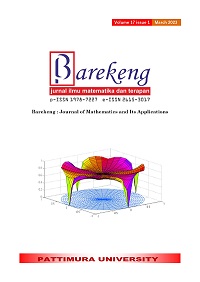THE IMPLEMENTATION OF FINITE-STATES CONTINUOUS TIME MARKOV CHAIN ON DAILY CASES OF COVID-19 IN BANDUNG
Abstract
Markov chain is a stochastic process to describe a phenomenon in the future based on a previous state. In practice, Markov chains are distinguished by time into two, namely discrete-time Markov chain and continuous-time Markov Chain. This research will discuss the continuous-time Markov chain with finite-state. COVID-19 phenomena can describe and predict using the continuous-time Markov chain. Authors use the data daily cases of COVID-19 in Greater Bandung including Bandung City, Bandung District, West Bandung District, Cimahi City and Sumedang District. Used data came from simulated data of daily cases of COVID-19 in Greater Bandung from August, 2020 until November 14, 2021 that recorded through the website COVID-19 of West Java. In terms of described and predicted the COVID-19 phenomenon in Greater Bandung for long-term probability, authors use stationary distribution and limit distribution. COVID-19 phenomenon is described into two states: state 0 (lower than average of data) and state 1 (higher than average of data). The result of continuous-time Markov chain with finite-state shows that the probability of the daily cases of COVID-19 for five locations in Greater Bandung is state 0 have a larger probability than state 1. It means that COVID-19 in Greater Bandung over the long-term will decrease.
Downloads
References
B. Desideria, “Sudah Sampai di Malaysia, Bagaimana dengan Indonesia?,” Liputan 6, 2021. https://www.liputan6.com/health/read/4705569/varian-corona-ay42-sudah-sampai-di-malaysia-bagaimana-dengan-indonesia (accessed Nov. 22, 2021).
Detikcom, “Kapan Sebenarnya Corona Pertama Kali Masuk RI,” Detik News, 2020. https://news.detik.com/berita/d-4991485/kapan-sebenarnya-corona-pertama-kali-masuk-ri (accessed Nov. 23, 2021).
A. W. Nugrahani, “Update Covid-19 Global 20 November 2021 Ada 19.824.086 Kasus Aktif Tercatat di Seluruh Dunia,” Tribun News, 2021. https://www.tribunnews.com/corona/2021/11/20/update-covid-19-global-20-november-2021-ada-19824086-kasus-aktif-tercatat-di-seluruh-dunia (accessed Nov. 21, 2021).
P. I. dan K. C.-19 P. J. Barat, “Data Kasus Covid-19 Jawa Barat (Public Version),” Pemerintah Provinsi Jawa Barat, 2021.
P. Monika, “Penerapan Script R Terintegrasi untuk Rantai Markov dalam Memprediksi Banyaknya Orang Terkonfirmasi Positif COVID-19 di Sumatera Barat,” Thesis: Universitas Padjadjaran, 2021.
A. R. Wiranto and A. Faisol, “Prediksi Pengeluaran Non Makanan Masyarakat Kabupaten Tulang Bawang Menggunakan Metode Rantai Markov,” J. Stat., vol. 15, no. 1, pp. 203–209, 2022.
T. Kurniaty, “Analisis Kejadian Hujan Di Bandung dengan Model Rantai Markov,” J. Stat. UNISBA, vol. 2, No 1, 2002, doi: https://doi.org/10.29313/jstat.v2i1.493.
K. Aritonang et al., “Analisis Pertambahan Pasien COVID-19 di Indonesia Menggunakan Metode Rantai Markov,” J. Rekayasa Sist. Ind., vol. 9, no. 2, pp. 69–76, 2020, doi: 10.26593/jrsi.v9i2.3998.69-76.
A. Hidayat, E. Sulistianingsih, and N. N. Debataraja, “Prediksi Jumlah Lulusan Dan Predikat Kelulusan Dengan Metode Rantai Markov,” Bul. Ilm. Math. Stat. dan Ter., vol. 04, no. 3, pp. 347–352, 2015.
E. Karyady, N. Satyahadewi, H. Perdana, and R. Markov, “Perhitungan premi asuransi jiwa dengan aplikasi rantai markov pada penderita penyakit jantung di kalimantan barat,” Bul. Ilm. Math. Stat dan Ter., vol. 11, no. 1, pp. 167–176, 2022.
Musafa, “KAJIAN MODEL HIDDEN MARKOV KONTINU DAN APLIKASINYA PADA HARGA BERAS (The Study of Continuous Hidden Markov Model and Its Application to The Price of Rice),” AdMathEdu J. Ilm. Pendidik. Mat. Ilmu Mat. dan Mat. Terap., vol. 8, no. 2, p. 125, 2018, doi: 10.12928/admathedu.v8i2.12267.
A. Din, A. Khan, and D. Baleanu, “Stationary distribution and extinction of stochastic coronavirus (COVID-19) epidemic model,” Chaos, Solitons and Fractals, vol. 139, p. 110036, 2020, doi: 10.1016/j.chaos.2020.110036.
Z. Xu, H. Zhang, and Z. Huang, “A Continuous Markov-Chain Model for the Simulation of COVID-19 Epidemic Dynamics,” Biology (Basel)., vol. 11, no. 2, 2022, doi: 10.3390/biology11020190.
M. Al-Zoughool et al., “Using a stochastic continuous-time Markov chain model to examine alternative timing and duration of the COVID-19 lockdown in Kuwait: what can be done now?,” Arch. Public Heal., vol. 80, no. 1, pp. 1–8, 2022, doi: 10.1186/s13690-021-00778-y.
V. Soukhovolsky, A. Kovalev, A. Pitt, and B. Kessel, “A new modelling of the COVID 19 pandemic,” Chaos, Solitons and Fractals, vol. 139, p. 110039, 2020, doi: 10.1016/j.chaos.2020.110039.
M. Backenköhler, L. Bortolussi, G. Großmann, and V. Wolf, “Analysis of Markov Jump Processes under Terminal Constraints,” pp. 210–229, 2021, doi: 10.1007/978-3-030-72016-2_12.
C. Sherlock, “Direct statistical inference for finite Markov jump processes via the matrix exponential,” Comput. Stat., vol. 36, no. 4, pp. 2863–2887, 2021, doi: 10.1007/s00180-021-01102-6.
J. R. Donsimoni, R. Glawion, B. Plachter, and K. Wälde, “Projecting the spread of COVID-19 for Germany,” Ger. Econ. Rev., vol. 21, no. 2, pp. 181–216, 2020, doi: 10.1515/ger-2020-0031.
D. Olabode, J. Culp, A. Fisher, A. Tower, D. Hull-Nye, and X. Wang, “Deterministic and stochastic models for the epidemic dynamics of COVID-19 in Wuhan, China,” Math. Biosci. Eng., vol. 18, no. 1, pp. 950–967, 2021, doi: 10.3934/MBE.2021050.
Y. Zhang, C. You, Z. Cai, J. Sun, W. Hu, and X.-H. Zhou, “Prediction of the COVID-19 outbreak based on a realistic stochastic model,” medRxiv, no. 1, p. 2020.03.10.20033803, 2020, [Online]. Available: http://medrxiv.org/lookup/doi/10.1101/2020.03.10.20033803
H. Pishro-Nik, “Introduction to Probability,” Probability Course, 2021. https://www.probabilitycourse.com/chapter11 (accessed Nov. 09, 2021).
S. Osaki, Applied Stochastic System Modeling Springer-Verlag, First. Berlin: Springer-Verlag, 1992. doi: 10.1007/978-3-642-84681-6.
Copyright (c) 2023 Putri Monika, Christophorus Soetikno, Atje Setiawan Abdullah, Budi Nurani Ruchjana

This work is licensed under a Creative Commons Attribution-ShareAlike 4.0 International License.
Authors who publish with this Journal agree to the following terms:
- Author retain copyright and grant the journal right of first publication with the work simultaneously licensed under a creative commons attribution license that allow others to share the work within an acknowledgement of the work’s authorship and initial publication of this journal.
- Authors are able to enter into separate, additional contractual arrangement for the non-exclusive distribution of the journal’s published version of the work (e.g. acknowledgement of its initial publication in this journal).
- Authors are permitted and encouraged to post their work online (e.g. in institutional repositories or on their websites) prior to and during the submission process, as it can lead to productive exchanges, as well as earlier and greater citation of published works.






1.gif)



